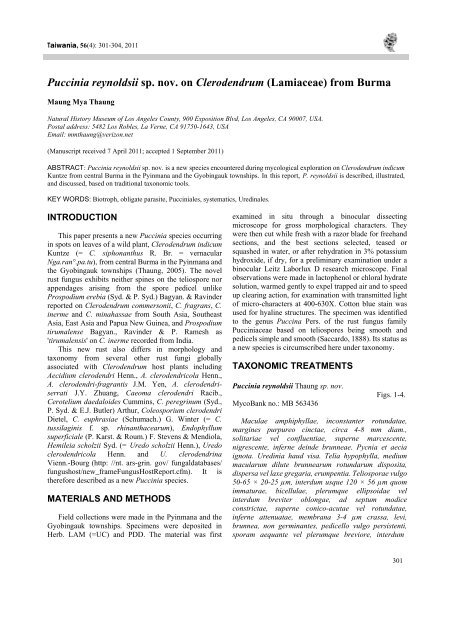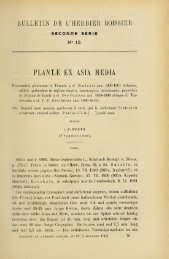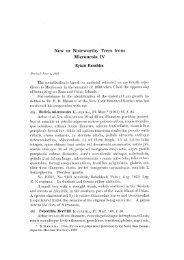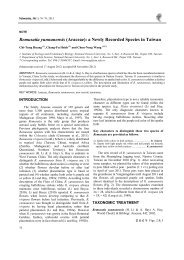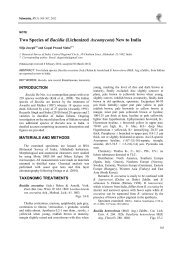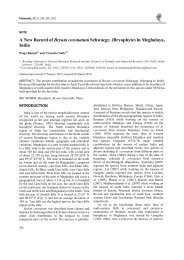Full text (PDF)
Full text (PDF)
Full text (PDF)
Create successful ePaper yourself
Turn your PDF publications into a flip-book with our unique Google optimized e-Paper software.
Taiwania, 56(4): 301-304, 2011<br />
Puccinia reynoldsii sp. nov. on Clerodendrum (Lamiaceae) from Burma<br />
Maung Mya Thaung<br />
Natural History Museum of Los Angeles County, 900 Exposition Blvd, Los Angeles, CA 90007, USA.<br />
Postal address: 5482 Los Robles, La Verne, CA 91750-1643, USA<br />
Email: mmthaung@verizon.net<br />
(Manuscript received 7 April 2011; accepted 1 September 2011)<br />
ABSTRACT: Puccinia reynoldsii sp. nov. is a new species encountered during mycological exploration on Clerodendrum indicum<br />
Kuntze from central Burma in the Pyinmana and the Gyobingauk townships. In this report, P. reynoldsii is described, illustrated,<br />
and discussed, based on traditional taxonomic tools.<br />
KEY WORDS: Biotroph, obligate parasite, Pucciniales, systematics, Uredinales.<br />
INTRODUCTION<br />
This paper presents a new Puccinia species occurring<br />
in spots on leaves of a wild plant, Clerodendrum indicum<br />
Kuntze (= C. siphonanthus R. Br. = vernacular<br />
Nga.ran°.pa.tu), from central Burma in the Pyinmana and<br />
the Gyobingauk townships (Thaung, 2005). The novel<br />
rust fungus exhibits neither spines on the teliospore nor<br />
appendages arising from the spore pedicel unlike<br />
Prospodium erebia (Syd. & P. Syd.) Bagyan. & Ravinder<br />
reported on Clerodendrum commersonii, C. fragrans, C.<br />
inerme and C. minahassae from South Asia, Southeast<br />
Asia, East Asia and Papua New Guinea, and Prospodium<br />
tirumalense Bagyan., Ravinder & P. Ramesh as<br />
'tirumalensis' on C. inerme recorded from India.<br />
This new rust also differs in morphology and<br />
taxonomy from several other rust fungi globally<br />
associated with Clerodendrum host plants including<br />
Aecidium clerodendri Henn., A. clerodendricola Henn.,<br />
A. clerodendri-fragrantis J.M. Yen, A. clerodendri-<br />
serrati J.Y. Zhuang, Caeoma clerodendri Racib.,<br />
Cerotelium daedaloides Cummins, C. peregrinum (Syd.,<br />
P. Syd. & E.J. Butler) Arthur, Coleosporium clerodendri<br />
Dietel, C. euphrasiae (Schumach.) G. Winter (= C.<br />
tussilaginis f. sp. rhinanthacearum), Endophyllum<br />
superficiale (P. Karst. & Roum.) F. Stevens & Mendiola,<br />
Hemileia scholzii Syd. (= Uredo scholzii Henn.), Uredo<br />
clerodendricola Henn. and U. clerodendrina<br />
Vienn.-Bourg (http: //nt. ars-grin. gov/ fungaldatabases/<br />
fungushost/new_frameFungusHostReport.cfm). It is<br />
therefore described as a new Puccinia species.<br />
MATERIALS AND METHODS<br />
Field collections were made in the Pyinmana and the<br />
Gyobingauk townships. Specimens were deposited in<br />
Herb. LAM (=UC) and PDD. The material was first<br />
examined in situ through a binocular dissecting<br />
microscope for gross morphological characters. They<br />
were then cut while fresh with a razor blade for freehand<br />
sections, and the best sections selected, teased or<br />
squashed in water, or after rehydration in 3% potassium<br />
hydroxide, if dry, for a preliminary examination under a<br />
binocular Leitz Laborlux D research microscope. Final<br />
observations were made in lactophenol or chloral hydrate<br />
solution, warmed gently to expel trapped air and to speed<br />
up clearing action, for examination with transmitted light<br />
of micro-characters at 400-630X. Cotton blue stain was<br />
used for hyaline structures. The specimen was identified<br />
to the genus Puccina Pers. of the rust fungus family<br />
Pucciniaceae based on teliospores being smooth and<br />
pedicels simple and smooth (Saccardo, 1888). Its status as<br />
a new species is circumscribed here under taxonomy.<br />
TAXONOMIC TREATMENTS<br />
Puccinia reynoldsii Thaung sp. nov.<br />
MycoBank no.: MB 563436<br />
Figs. 1-4.<br />
Maculae amphiphyllae, inconstanter rotundatae,<br />
margines purpureo cinctae, circa 4-8 mm diam.,<br />
solitariae vel confluentiae, superne marcescente,<br />
nigrescente, inferne deinde brunneae. Pycnia et aecia<br />
ignota. Uredinia haud visa. Telia hypophylla, medium<br />
macularum dilute brunnearum rotundarum disposita,<br />
dispersa vel laxe gregaria, erumpentia. Teliosporae vulgo<br />
50-65 × 20-25 µm, interdum usque 120 × 56 µm quom<br />
immaturae, bicellulae, plerumque ellipsoidae vel<br />
interdum breviter oblongae, ad septum modice<br />
constrictae, superne conico-acutae vel rotundatae,<br />
inferne attenuatae, membrana 3-4 µm crassa, levi,<br />
brunnea, non germinantes, pedicello vulgo persistenti,<br />
sporam aequante vel plerumque breviore, interdum<br />
301
302<br />
Taiwania Vol. 56, No. 4<br />
Fig. 1. Clerodendrum indicum Kuntze leaves with subglobose spots of rust. Bar = 1.5 cm.<br />
Fig. 2. Puccinia reynoldsii – Telium with young teliospores. Bar = 30 µm.
December, 2011 Thaung: A new Puccinia species in Burma<br />
Fig. 3. Puccinia reynoldsii – Young developing teliospores.<br />
Bar = 30 µm<br />
oblique affixo, attenuato, simplici, hyalino; mesosporae<br />
25-30 × 20-25 µm, unicellulae.<br />
Holotypus: BURMA, Pyinmana, on leaves of<br />
Clerodendrum indicum Kuntze (Lamiaceae), 13 Dec<br />
1977, leg. et det. Maung Mya Thaung (LAM (=UC)<br />
220424-III-holotypus, PDD 56247-III-isotypus);<br />
BURMA, Gyobingauk, on leaves of Clerodendrum sp.<br />
(Lamiaceae), 18 Dec 1977, leg. et det. Maung Mya<br />
Thaung (LAM (=UC) 220978-III-paratypus).<br />
Spots on both sides of leaf, subglobose, pinkish to<br />
purplish at margin, about 4-8 mm diam, separate or<br />
coalescing, fading to dark grey above, becoming brown<br />
below (Fig. 1). Pycnia and aecia unknown. Uredinia not<br />
seen. Telia hypophyllous, dispersed or loosely grouped,<br />
becoming erumpent. Teliospores generally 50-65 ×<br />
20-25 µm, sometimes up to 120 × 56 µm when<br />
immature, 2-celled, mostly ellipsoid or occasionally<br />
short-oblong, moderately constricted at septum,<br />
conic-acute to round above, attenuate below, wall 3-4<br />
µm thick, smooth, brown, not germinating, pedicel<br />
commonly persistent, equal to spore in length or<br />
generally shorter, sometimes obliquely attached,<br />
attenuate, simple, hyaline; mesospores 25-30 × 20-25<br />
µm, 1-celled (Figs. 2-4).<br />
Etymology: Named after Dr Don R. Reynolds,<br />
Research Botanist, Herbarium, University of California,<br />
Berkeley, for his enthusiastic support for the study of<br />
fungi from Burma.<br />
DISCUSSION<br />
Puccinia reynoldsii sp. nov. produces mesospores<br />
Fig. 4. Puccinia reynoldsii – Teliospores and mesospores.<br />
Bar = 30 µm.<br />
just like Prospodium tirumalense, but differs from<br />
Prospodium erebia and P. tirumalense in having smooth<br />
teliospores and simple, smooth pedicels. Moreover, it<br />
utilizes an entirely distinct host plant species,<br />
Clerodendrum indicum, in Lamiaceae while<br />
Prospodium rusts are geographically restricted largely<br />
to the Americas and the Caribbeans on Bignoniaceae and<br />
Verbenaceae (Cummins and Hiratsuka, 2003).<br />
LITERATURE CITED<br />
Cummins, G. B. and Y. Hiratsuka. 2003. Illustrated Genera<br />
of Rust Fungi. 3rd ed. American Phytopathological Society<br />
Press, St. Paul, MN, USA. 225pp.<br />
Saccardo, P. A. 1888. Puccinia graminis Pers. Sylloge<br />
Fungorum. 7: 622.<br />
Thaung, M. M. 2005. Rusts, smuts and their allies in Burma.<br />
Australas Mycol. 24: 29–46.<br />
USDA, A. R. S. 2011. http://nt.ars-grin.gov/fungaldatabases/<br />
fungushost/ fungushost.cfm, accessed on 4/06/11.<br />
303
304<br />
Taiwania Vol. 56, No. 4<br />
緬甸於大青屬(Clerodendrum)植物體上的新種銹菌 – Puccinia reynoldsii<br />
Maung Mya Thaung<br />
Natural History Museum of Los Angeles County, 900 Exposition Blvd, Los Angeles, CA 90007, USA.<br />
Postal address: 5482 Los Robles, La Verne, CA 91750-1643, USA.<br />
Email: mmthaung@verizon.net<br />
(收稿日期:2011 年 4 月 7 日;接受日期:2011 年 9 月 1 日)<br />
摘要:在一次真菌調查中,於中緬甸的 Pyinmana 及 the Gyobingauk 鎮,長管大青<br />
(Clerodendrum indicum Kuntze)這種植物上發現一新種銹菌 – Puccinia reynoldsii。本文提<br />
供該新種之描述、圖片並進行討論。<br />
關鍵詞:活體營養生物、絕對寄生菌、柄銹菌目、系統分類學、銹菌目。


